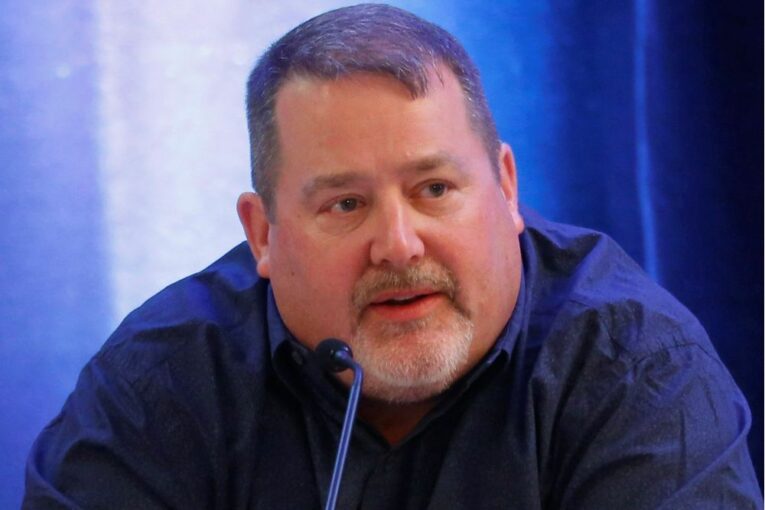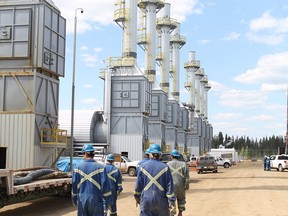
Does Alex Pourbaix, CEO of one of Canada’s largest oilsands operators, think the “just transition” legislation and energy transition will mean less work in the country’s oil and gas sector?
No, he says flatly on the phone from Toronto.
But the head of Cenovus Energy also doesn’t like the “poorly chosen term” of just transition and the message it sends that his sector isn’t a place workers want to join.
“I would be concerned if I thought that was going to turn into a serious attempt to kind of move highly paid workers out of the oil and gas industry and into new industries, but I don’t think that is . . . what the (federal) government’s intent is,” Pourbaix said Wednesday in an interview.
“This transition, if done correctly and if we’re able to materially decarbonize the Canadian barrel of oil, I actually think it should result in more jobs — and materially more jobs — in the Canadian energy sector.”
The issue of the federal government’s incoming just transition legislation, which Ottawa is expected to introduce early this year, has mushroomed into a political battle in Alberta.
The bill is supposed to help workers and communities prepare for a transition to a low-carbon economy as the country aims to cut its greenhouse gas emissions and reach a net-zero goal by 2050, part of Canada’s climate plan.
A federal discussion paper says Ottawa “also recognizes that the transition will have varying impacts across the country.” In Alberta, where thousands of jobs are rooted in the sector, this is critical.
There is talk about oilpatch workers affected by the transition being able to shift into new areas, such as the country’s growing cleantech sector; areas such as geothermal, hydrogen and renewable energy are expanding.
“The federal government’s sustainable jobs plan is not about eliminating jobs; it is meant to create jobs,” Ian Cameron, director of communications for Natural Resources Minister Jonathan Wilkinson, said Wednesday in an e-mail.
Alberta Premier Danielle Smith, and some in the oilpatch, believe this is simply a federal signal that Ottawa is preparing to shift jobs out of the fossil fuel industry.
“They need to stop this language,” Smith told reporters recently. “It means phasing out oil and natural gas workers. And that is not on.”

Pourbaix believes the Canadian oilsands can grow employment — and production — in the future if it successfully lowers its carbon emissions.
The Pathways Alliance, a group of oilsands operators in Canada — including Cenovus — are working together to reach the net-zero target by 2050.
Their strategy includes spending $24 billion by 2030 on various decarbonization projects, including $16.5 billion for a carbon capture and storage system that connects multiple oilsands facilities to a hub near Cold Lake.
They are also seeking significant incentives from both Ottawa and the provincial government to make investments in carbon capture, utilization and storage (CCUS), which puts them in a delicate position between two feuding governments.
“We are trying to decarbonize the oilsands barrel and we believe that if we are successful . . . we should have a green light to grow production of Canadian oil,” Pourbaix said.
“The capital projects that are going to come out of the decarbonization, the carbon capture, the CO2 pipeline . . . I really do see those as kind of the next big boom for Alberta.”
The group estimates its plan could employ up to 35,000 additional people, tied to construction and cleantech, by 2030, if it proceeds with its various initiatives.
“This is a rare moment where oil CEOs and Greenpeace are in agreement on the fact that the energy transition is going to be a massive job creator,” said Keith Stewart of Greenpeace Canada.
“We will disagree on precisely what the relative share of those jobs will be.”
Recommended from Editorial
-

Braid: Federal memo shows heavy impact of ‘just transition’ on Alberta
-

‘Just transition’ echoes National Energy Program but political leadership and climate have changed: professor
-

Varcoe: Ottawa’s ‘just transition’ rhetoric adds to oilpatch labour crunch
Energy analyst Jared Dziuba of BMO Capital Markets agrees with Pourbaix that low-carbon projects — such as work on biofuels, hydrogen and CCUS — will create additional employment within the oil and gas industry.
The question is if the federal legislation, along with a cap on oilpatch emissions, is intended to force a movement of people away from the sector, he said.
“That’s where the debate is: Does the federal government actually need to step in and try to accelerate the movement of the mobility of labour from one industry into another,” Dziuba said.
About 188,000 Canadians worked in the oil and gas industry in December, including 137,000 people in Alberta, according to data from the PetroLMI division of Energy Safety Canada.
Pourbaix doesn’t like the just transition term, a point that Smith and many others have made. He said it “erroneously puts out the view that this industry is not a place where people want to work or where new workers want to go. And I think that’s demonstrably not the case.”
While Pourbaix doesn’t think it makes it harder for Cenovus to attract new workers — the integrated producer has more than 6,000 employees — oilfield services firms have criticized it for making recruitment more difficult.
He also doesn’t see any great urgency to move ahead with the legislation until there’s a meeting of the minds over what it means and how it would work.
But the potential for more jobs in the future rests on the sector proceeding with major capital spending plans. It will require both levels of government and the private sector to reach an accord that will trigger CCUS investment.
Pourbaix believes they will find common ground, but if that doesn’t happen it would be a “really tragic day for Canada,” he said.
“The outcome of that would probably be a much smaller industry, and that would be a tragedy for Canada if that were to occur — and that’s why I don’t think it will occur.”
Chris Varcoe is a Calgary Herald columnist.
You can read more of the news on source
